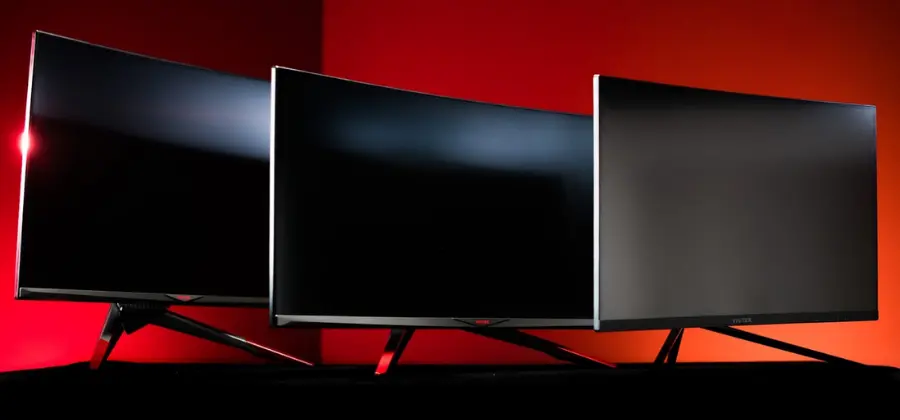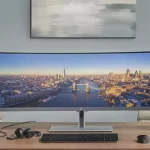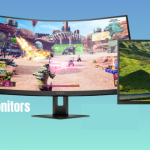As We have told you, not all monitors have the same features. Therefore, if you want to find a perfect monitor for you, you must evaluate a series of characteristics and make sure that they adapt to your needs or budget.
Related Article: Gigabyte M34Wq Review
How To Choose A Best Monitor?
Screen size
This is one of the first aspects that you must define before making your purchase. You should know that to choose the size of the monitor well, you must consider two factors: the distance you will sit from the screen and the space available on the table. In this case, bigger is not always better. If you are going to be only 40 or 50 cm away, it will not be worth buying a 32-inch monitor.
Not only will it be uncomfortable because you won’t have a panoramic view of the monitor, but you could also end up with cervical pain from having a forced position. Currently, the standard size is between 22 and 25 inches, and in this case, it is appropriate to have a distance of between 50 and 60 cm between you and the monitor.
If you have a large table and a sufficient viewing distance of more than 70 cm, you can buy a 27-inch model. If you don’t have a lot of space, you can find good options with sizes between 17 and 21 inches. Although they are not very large monitors, with them you can be at a distance of between 30 and 50 cm without a problem.
Related Article: Gigabyte Aorus Fo48U Review
Display Technology
You may have seen monitors that look very similar on the surface but have a noticeable price difference. This discrepancy may not only be due to the brand, but also to the display technology. In the past, monitors used CRT technology, but this has been replaced by LCD, which offers thinner and brighter panels. This does not mean that when buying a monitor you should only choose LCD since this technology offers three different types of panels: TN, VA, or IPS.
It is important that you know them so that you can determine which one suits you best.
- TN (Twisted nematic) panels are characterized by having a fast response time (2 ms or less) and being economical. However, its viewing angles are not that good and it has low light.
- VA (Vertical Alignment) panels have better viewing angles than TN panels, as well as higher brightness and better color reproduction. As a counterpart, its response time is less than that of a TN panel.
- IPS (n-Plane Switching) panels, on the other hand, are characterized by offering excellent viewing angles, having more accurate colors, and, in general, better image quality. On the downside, these monitors are slower, both in input lag and response time. Also, they are more expensive.
Related Article: Hp Omen 25I Review
Monitor resolution
The resolution is one of the features that buyers know the most because it is one of the most advertised by brands to sell their equipment. However, it is important that you consider the resolution based on the size of the monitor. For a model smaller than 19 inches, the resolution can be between 1024 x 768 and 1280 x 1024. If the monitor is 19 to 23 inches, the resolution must be at least 1366 x 768 and 1920 x 1080. And if it is larger than 23 inches it must be at least 1920 x 1080.
Today it is common for brands to focus on their 4K monitors because they promise great image quality. But pay attention, you may not need that much resolution. Before buying a monitor with 4K resolution, you must first make sure that you have a suitable PC for it, and you must also consider the use that you are going to give it.
Today’s modern graphics cards can handle this kind of resolution, but it won’t have the same needs for a user who wants the monitor for multimedia entertainment as one who wants it for gaming or work.
These recommendations can help you know if you need a 4K monitor or not.
- Full HD resolution: it will serve you to work, for entertainment and to play with a normal graphic.
- 1440p resolution: it will be useful for graphic design tasks and for playing games with powerful graphics.
- 4K resolution: it will help you to see content in 4K, to play with top-of-the-range graphics, for graphic design tasks and CAD applications.
- Now that you know this information, it is important that you analyze your needs and the use you plan to give the monitor so that you can choose the most appropriate resolution.
Related Article: Huawei Mateview Gt Reviews
Monitor response time
Response time refers to how long it takes for a pixel to change the color it is displaying. It is a parameter that is measured in milliseconds, and the lower this number, the better the user experience.
Most monitors have a response time of between 5 and 1 ms. This is more than an acceptable time for the monitor to work properly. However, if you are going to buy it specifically to play, it is best to look for models with a response time of 1 ms so that you have a good gaming experience every time. But if your goal is to buy a monitor for work or multimedia entertainment, you should not worry about this factor.
Related Article: Huawei Mateview Review
Connectivity
An important aspect that you should evaluate is the connectivity of the monitor. It is important that it has a good number of input connectors, from the basic analog connections to the most modern so that you do not have problems when connecting the different equipment you use.
In addition to the classic VGA connections and traditional USB ports, it is important that it includes USB 3.0 and USB 3.1 (USB C or Type-C), DVI, HDMI, and/or Display Port ports. The most modern ones such as the Display Port allow higher resolutions and refresh rates to be transported.
Related Article: Lenovo Lt2452P Review
Characteristics
The monitors may have some extra features or technologies that could improve the use of the equipment. One thing you should consider is whether the monitor supports HDR, which is the standard that defines the ratio of light to dark areas in an image.
Most monitors support HDR10 and can go up to 10-bit color depth. However, the most current models can be compatible with HDR10 +, which can go up to 12 bits.
Optionally, you can also choose a monitor that has speakers so you can play audio or make video calls without having to connect an additional sound system.
Related Article: Aoc E2352Phz Review
Design
The design is another aspect that, although it does not interfere with the functionality of the monitor, is worth considering to improve the user experience. Today it is increasingly common to find models with very narrow bezels, which means that practically the entire front is a screen. In this way, the diagonal of the screen is used much better.
In addition, reduced frames also add a lot of style to the monitor. Depending on the color you choose, you can also get a screen with a minimalist and elegant style that integrates well with the rest of the elements. In terms of design, you can also opt for curved monitors, although these do not work well for all uses and are also more expensive.
Price
The price range of monitors is very varied. The entry range is in fact very cheap, with models even below 100$. However, the premium range can be very expensive, with options of more than 650$ such as the Acer Predator Z35P model, 35-inch curved and with a resolution of 3440 x 1440 pixels.
That does not mean that you cannot find good alternatives at balanced prices. Between 200 and 500$ you will find many quality monitors, with good size and resolution. Of course, if your budget is limited, better forget about high resolutions, diagonals, or curved panels.
Fortunately, the wide variety can also help you buy a quality monitor adapted to your needs and your budget. You just have to search and choose well.
Related Article: Asus Mx299Q Review
Brand
If you are wondering which is the best brand of monitors, the answer can be very complex.
And it is that in reality there are many good brands that you can buy for prices adapted to your budget.
However, if I have to talk about some prominent monitor brands, the list includes ASUS, LG, Samsung, Acer, MSI, AOC, HP, Philips, Dell, and Gigabyte.


